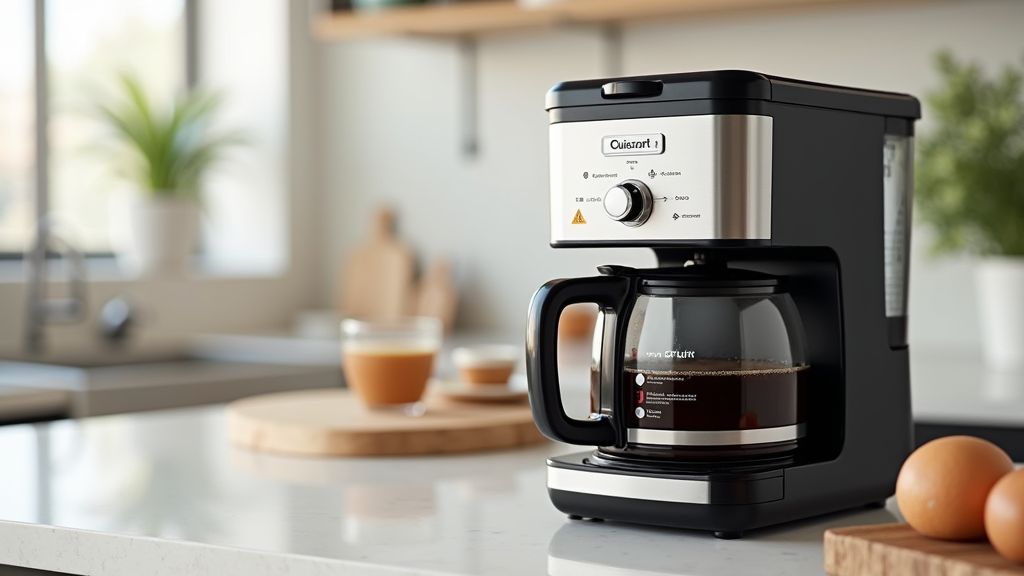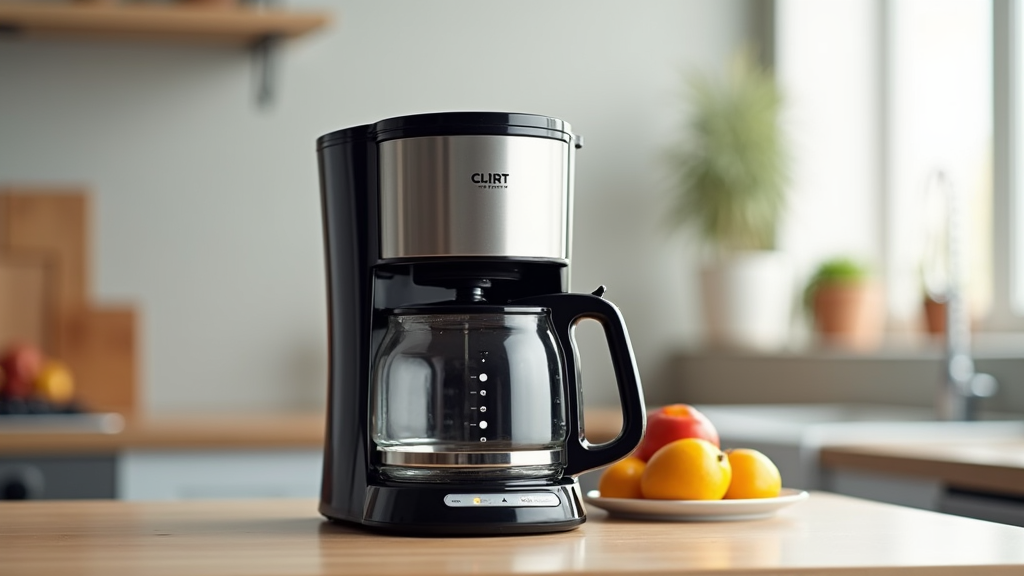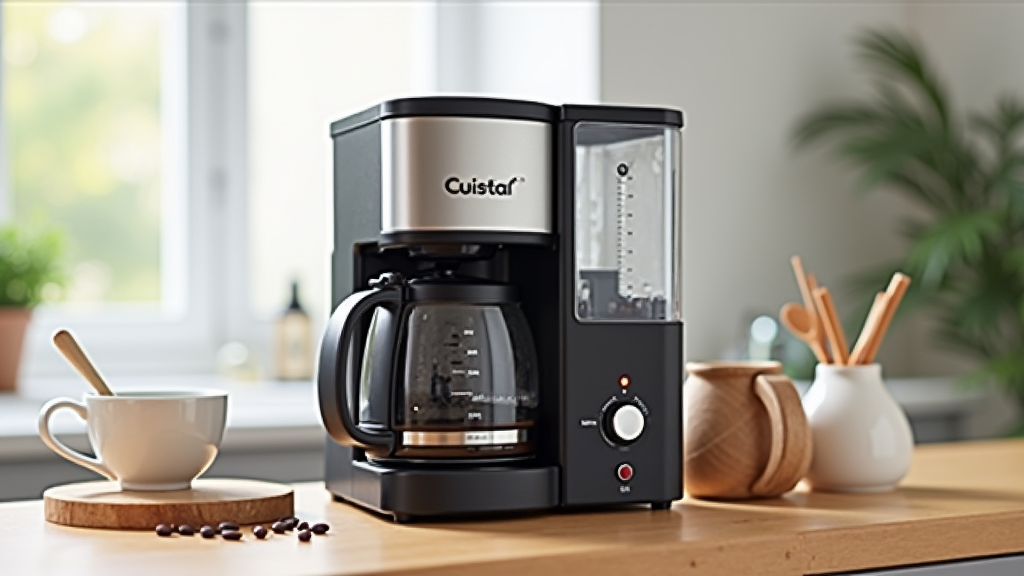Table of Contents
- Understanding How to Self Clean Your Cuisinart Coffee Maker
- Understanding How to Clean Your Cuisinart Coffee Maker
- Detailed Guide: How to Self Clean Cuisinart Coffee Maker
- Alternative Cleaning Methods for Cuisinart Coffee Makers
- Post-Cleaning Maintenance for Your Cuisinart Coffee Maker
Understanding How to Self Clean Your Cuisinart Coffee Maker

Why Self-Cleaning is Vital for Cuisinart Coffee Makers
The self-clean feature is absolutely essential for keeping your Cuisinart coffee maker in top condition. It’s not just about hygiene; it directly impacts the taste of your coffee and the longevity of your appliance.
Regularly using the self-clean function removes mineral deposits and accumulated coffee oils, both of which can negatively affect the flavor of your brew and the overall performance of the machine. Neglecting this simple maintenance task can lead to a buildup that eventually clogs the system and reduces the lifespan of your coffee maker.
For optimal performance, it’s generally recommended to run the self-clean cycle every 1-3 months. However, if you live in an area with hard water, you might need to clean it more frequently to prevent excessive mineral buildup.
The Problem: Mineral Buildup in Coffee Makers
Mineral buildup is a common problem with all coffee makers, especially in areas with hard water. As water heats up and flows through the machine, minerals like calcium and lime can precipitate out and form deposits inside the reservoir, tubes, and heating element.
In addition to mineral buildup, coffee oils can also accumulate over time. These oils, extracted from the coffee grounds during brewing, can leave a residue that affects the taste of your coffee, making it bitter or stale. Cuisinart coffee makers often include a self-clean feature specifically designed to combat these issues and maintain optimal brewing conditions.
Many Cuisinart models even have an indicator light that will illuminate to signal when it’s time to run the self-clean cycle, taking the guesswork out of maintenance.
What You Will Learn: Cuisinart Self Clean Guide
In this guide, you’ll learn everything you need to know about using the self-clean function on your Cuisinart coffee maker. We’ll cover each step in detail, from preparing your machine for cleaning to maintaining it afterward.
- You’ll discover how to properly prepare your Cuisinart coffee maker before initiating the self-cleaning cycle.
- We’ll provide step-by-step instructions on how to effectively use the self-clean function, ensuring a thorough cleaning process.
- You’ll also receive valuable tips for maintaining your coffee maker after cleaning, helping to prevent future buildup and prolong its lifespan.
- Finally, we’ll discuss alternative cleaning methods for Cuisinart coffee maker models that may not have a dedicated self-clean function.
Understanding How to Clean Your Cuisinart Coffee Maker
Key Culprits: Mineral Deposits and Coffee Oils
Over time, your Cuisinart coffee maker can accumulate mineral deposits, primarily calcium and lime, from the water you use. These deposits can affect the taste of your coffee and the performance of your machine. Additionally, coffee oils, a residue from coffee grounds, can build up and become rancid, further impacting the flavor.
The Purpose of the Cuisinart Self-Clean Cycle
The self-clean cycle on your Cuisinart coffee maker is an automated process designed to dissolve these mineral deposits and coffee oils. It uses a cleaning solution, typically a mixture of water and vinegar, to thoroughly clean the internal components of the machine.
Essential Cleaning Components for Your Cuisinart
To effectively use the self-clean function, you’ll need a few key components:
- White Vinegar:A natural and effective cleaning agent with 5% acidity. It helps to break down mineral deposits.
- Water:Used to dilute the vinegar and thoroughly rinse the machine after cleaning.
- Carafe:To collect the cleaning solution during the self-clean cycle and the rinse water afterwards.
- Filter Basket:This must be completely empty during the self-clean cycle.
Preparing the Filter Basket for Self-Cleaning
Before initiating the self-clean cycle, ensure the filter basket is empty. This involves removing any remaining coffee grounds and disposing of the old filter. After the cycle, ensure the filter basket is properly aligned during reassembly to avoid any issues during brewing.
Note that some Cuisinart models have permanent filters. These filters should be removed and cleaned separately according to the manufacturer’s instructions before running the self-clean cycle.
Detailed Guide: How to Self Clean Cuisinart Coffee Maker

**Key Takeaway:** Regular cleaning with a vinegar and water solution or a commercial cleaner is crucial for maintaining your Cuisinart coffee maker’s performance and longevity. Remember to rinse thoroughly with fresh water after the cleaning cycle, and consider using filtered water regularly to minimize mineral buildup and extend the time between cleanings.
Preparation: Cleaning Your Cuisinart Coffee Maker
Before initiating the self-clean cycle on your Cuisinart coffee maker, proper preparation is essential. This ensures the process is effective and safe for your appliance.
- Required Materials:
- White distilled vinegar (approximately 2-4 cups, depending on the model).
- Water (approximately 4-8 cups, depending on the model).
- Clean cloth or sponge.
- Empty coffee filter (optional, for rinsing).
Initial Setup:
- Turn off and unplug the coffee maker.
- Empty any remaining water or coffee from the carafe and reservoir.
- Remove the filter basket and any coffee grounds.
Important Considerations:
- Refer to your Cuisinart coffee maker’s user manual for specific instructions and recommendations.
- Ensure the area around the coffee maker is clear and accessible.
Step-by-Step: Running Cuisinart’s Self-Clean Cycle
Follow these steps carefully to properly execute the self-clean cycle on your Cuisinart coffee maker.
Step 1: Empty the Coffee Maker
Remove any leftover coffee, filters, and coffee grounds. Clean the carafe separately with warm, soapy water and rinse thoroughly.
Step 2: Prepare the Cleaning Solution
Mix white vinegar and water in the reservoir. A common ratio is 1/3 white vinegar and 2/3 water. For example, for a 12-cup coffee maker, use 4 cups of vinegar and 8 cups of water. Alternatively, use a commercial coffee maker cleaning solution, following the manufacturer’s instructions for dilution (e.g., 2 oz cleaner per 10 oz water).
Step 3: Activate Self-Clean Cycle
Plug in the coffee maker. Pour the cleaning solution into the water reservoir. Press the “Self Clean” button. The location of this button varies by model (refer to the control panel). Some models may require you to select a brew size or cycle type (e.g., “Full Pot”).
Step 4: Complete the Cycle
Allow the self-clean cycle to run for approximately 30 minutes. The exact duration may vary by model. The “Self Clean” light will usually remain illuminated during the cycle. Some models beep 5 times when the cycle is complete.
Step 5: Rinse the Coffee Maker
Empty the carafe and reservoir after the cleaning cycle is finished. Fill the reservoir with fresh, clean water and run a complete brew cycle to rinse. Repeat this rinsing process at least twice to ensure all traces of vinegar or cleaning solution are removed.
Step 6: Wipe Down Exterior
Clean the exterior of the coffee maker with a soft cloth or sponge to remove any spills or residue.
Step 7: Replace Components
Reinstall any removable parts, such as the filter basket and carafe.
Advanced Techniques: Optimizing Cuisinart Coffee Maker Cleaning
Enhance your cleaning routine with these expert tips and troubleshooting advice for your Cuisinart coffee maker.
Expert Tips
Use filtered water in your coffee maker to minimize mineral buildup in the first place. Replace water filters every 60 days or after 60 uses, whichever comes first.
Optimization Methods
If the self-clean light continues to blink after one cycle, repeat the cleaning process with a fresh vinegar-water solution. For heavy mineral buildup, consider using a stronger vinegar solution (e.g., 50/50 vinegar and water).
Troubleshooting
If the self-clean cycle is accidentally triggered, press the “Self Clean” button again to cancel it (if possible). If the machine continues to blink, ensure the vinegar solution is mixed correctly and the machine is properly rinsed after cleaning. If you need to stop the cycle early, you can usually do so by pressing any key on the coffee maker or by turning the machine off.
Alternative Cleaning Methods for Cuisinart Coffee Makers
Manual Cleaning Process for Cuisinart Coffee Makers
Even without a self-clean function, you can effectively clean your Cuisinart coffee maker manually. This process involves using a vinegar solution to descale and remove mineral buildup.
Preparing Your Cuisinart Coffee Maker for Manual Cleaning
Before you begin, ensure your coffee maker is safely unplugged from the power outlet. Then, empty any remaining water or coffee grounds from the machine.
Remove all detachable parts, including the water reservoir, the carafe, and the filter basket. These components will be cleaned separately.
Creating a Vinegar Cleaning Solution for Coffee Makers
Prepare a cleaning solution by mixing one part white distilled vinegar with two parts water. A common ratio is four cups of water and two cups of vinegar for a standard-sized Cuisinart coffee maker.
Step-by-Step Guide to Manually Cleaning Your Coffee Maker
Follow these steps to thoroughly clean your Cuisinart coffee maker:
- Pour the vinegar-water solution into the water reservoir of your coffee maker.
- Place the empty carafe on the warming plate to catch the solution.
- Manually initiate a full brew cycle, allowing the vinegar solution to run through the machine.
- After the brew cycle completes, let the solution sit in the carafe for approximately 30 minutes. This allows the vinegar to further break down mineral deposits.
- Discard the vinegar solution from the carafe and thoroughly rinse both the carafe and the water reservoir with clean water.
- Run at least two full brew cycles with fresh, clean water to eliminate any residual vinegar taste or odor.
- Wash all removable parts, such as the filter basket and carafe lid, with warm, soapy water. Rinse them thoroughly and allow them to air dry.
- Finally, wipe down the exterior of the coffee maker with a damp cloth to remove any spills or stains.
Post-Cleaning Maintenance for Your Cuisinart Coffee Maker

Regular Maintenance After Cuisinart Self-Cleaning Cycle
After running the self-clean cycle on your Cuisinart coffee maker, consistent maintenance is key to prolonging its life and ensuring the best-tasting coffee. Wipe down the exterior of the coffee maker with a damp cloth after each use. This prevents stains and buildup from coffee spills and condensation.
Regularly clean the removable parts such as the filter basket and carafe. Wash them with warm, soapy water, rinse thoroughly, and dry completely before reassembling. Proper cleaning of these components helps prevent residue buildup that can affect the flavor of your coffee.
When not in use, store your Cuisinart coffee maker in a dry place. This helps prevent the growth of mold and mildew, especially in areas with high humidity.
Determining the Frequency of Cuisinart Coffee Maker Cleaning
The ideal frequency for cleaning your Cuisinart coffee maker depends on several factors, including the hardness of your water and how often you use the machine. Generally, aim to clean it every 1 to 3 months.
If you notice a change in the taste of your coffee, such as a bitter or metallic flavor, or if the coffee maker’s performance seems sluggish, it’s a sign that you should clean it more frequently. Mineral buildup can significantly impact both taste and performance.
Additional Tips for Cuisinart Coffee Maker Upkeep
Using filtered water is one of the best ways to minimize mineral buildup in your Cuisinart coffee maker. Filtered water contains fewer impurities and minerals that can lead to scale and affect the taste of your coffee.
Consider using a specialized coffee machine cleaner for a deeper clean. These cleaners are designed to remove mineral deposits and coffee oils without damaging the machine. However, avoid using abrasive cleaners or harsh chemicals, as they can scratch or corrode the coffee maker’s internal components.
Always refer to your Cuisinart coffee maker’s user manual for specific cleaning instructions and recommendations. The manual provides detailed information on the proper cleaning procedures and any specific requirements for your model.

